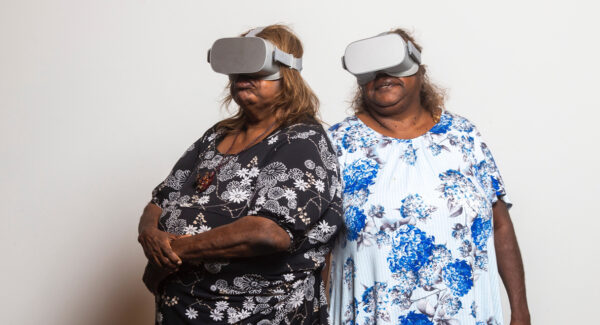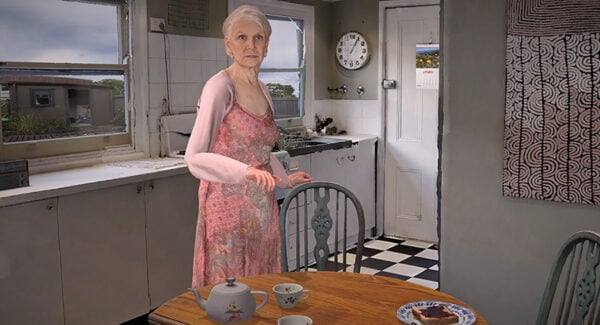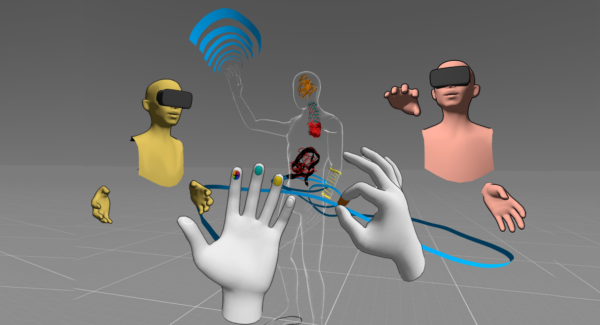Experience a range of interactive virtual-reality experiences that champion positive mental health and delve into issues faced by the community.
This showcase of AR and VR media tools has been developed by the Felt Experience & Empathy Lab (fEEL). fEEL brings together psychologists and arts researchers utilising immersive visualisation technology to advance the study of subjective experience. With the larger social goal of transforming our capacity to understand stigmatised and devalued populations, and of effectively remediating the effects of stigmatisation and prejudice, it generates insight into first-person perspectives and the dynamic connections that promote societal empathy.
The following experiences will be part of the showcase:
Waumananyi
Working with the Big Anxiety and fEEL, Uti Kulintjaku (NPY Women’s Council) have created Waumananyi: The Song on the Wind, an Anangu-led response to the experiences of constraint, entrapment, and depression through the traditional story (or ‘tjukurpa’) of ‘The Man in the Log’.

Image: Nyunmiti Burton and Pantjiti Lewis at NPY Uti Kulintjaku VR workshop, Alice Springs, 2019.
Photo: Rhett Hammerton.
The Visit
An intimate interactive engagement with the complex emotional and perceptual world of dementia. Visitors are invited to sit with Viv, a life-sized, photorealistic animated character whose dialogue is created largely from verbatim interviews, drawing us into a world of perceptual uncertainty, while at the same time confounding stereotypes and confronting fears about dementia.

Image: Still from The Visit.
Parragirls, Past Present
Parragirls, Past Present is a deeply moving immersive experience presenting former residents’ contemporary visions of Parramatta Girls Home, a punitive Australian child welfare institution that closed in 1974. Unlocking contested memories of institutional ‘care’, this collaboration with media artists and Parragirls rewrites the history of Parramatta Girls Home. Parragirls Past, Present is presented as a 23min Virtual Reality film.

Image: fEELab.
Being Debra by artist Debra Keenahan
Employing Virtual Reality (VR), Being Debra offers the audience a taste of the embodied experience of being a dwarf in contemporary Australian society (with all its challenges, ugliness and triumphs). Shot from a first-person perspective with a 180 degree camera, the project was initiated by artist Debra Keenahan who lives with achondroplasia dwarfism. The VR experience includes flashbacks to Debra’s memories of school, dating, and engaging with authority figures, including doctors, as well as her routine daily encounters in a park.

Embodimap
A therapeutic/research tool that enables users to engage with and map their feelings, thoughts and emotions and how these are experienced within the body.

Image: EmbodiMap shared experience and hand interaction.
Waumananyi
This Anangu-led project is a collaboration between NPY Women’s Council and fEEL. Uti Kulintjaku is an award-winning initiative of the Ngangkari Program that supports mental health understanding. Led by ngangkari and senior Anangu, Uti Kulintjaku encourages deeper conversations about mental health and healing for Anangu and people working in Aboriginal health and related services. It takes its name from a Pitjantjatjara phrase that means ‘to listen, think and understand clearly’
Hard Place/Good Place
A creative research project, led by the fEEL Lab at UNSW.
EmbodiMap
Created by fEEL, felt Experience and Empathy Lab — who are available to discuss various applications related to trauma and mental health.
fEEL has been established through funding from the Australian Research Council Laureate Fellowship awarded to Scientia Professor Jill Bennett, Director of the Big Anxiety Research Centre at UNSW Art, Design & Architecture.
The Visit
Director and Producer: Jill Bennett
Art Director and Production Design: Volker Kuchelmeister
Voice actress: Heather Mitchell
Motion Capture actress: Emma Kew
Script: Jill Bennett, Natasha Ginnivan
Script consultants: Melissa Neidorf, Gail Kenning, David Pledger
Interviewees/contributors: Prue Uther, Joan Eva, Jennifer Bute, Wendy Mitchell
Researchers: Natasha Ginnivan, Chris Papadopoulos, Melissa Neidorf, Gail Kenning
Motion Capture: Joe Holloway
Voice recording: Tobias Gilbert
3D Artist: Chris Norris, Jason Dobra
3D scanning: Matt Cabanag (UNSW LITEroom)
LIDAR: Bruce Harvey (UNSW Engineering)
Music: Peter Sculthorpe String quartet no. 16 : for string quartet with optional didjeridu (2005), by Peter Sculthorpe, performed by Del Sol Quartet and Courtesy of Sono Luminus. Music published by Faber Music Ltd and used by permission of Hal Leonard Australia
Parragirls, Past Present
Art Director and Production Design: Volker Kuchelmeister
Sound Design/Editor: Alex Davies
Writer/Editor: Lily Hibberd
Writer/Narrator: Bonney Djuric, Jenny McNally
Narrator: Lynne Edmondson Paskovski, Gypsie Hayes, Denise Nicholas
Co-producers: Jill Bennett, Bonney Djuric, Lily Hibberd
RMIT Culture Project Manager: Helen Withycombe




